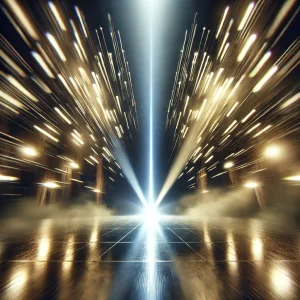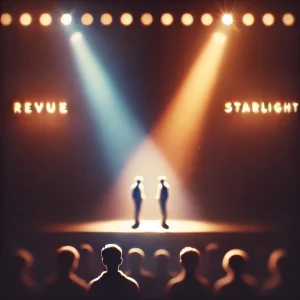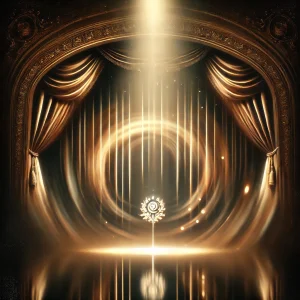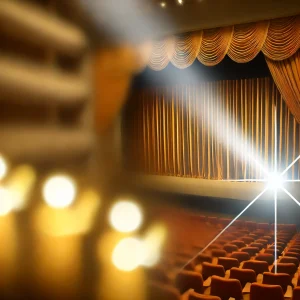Introduction to Revue Starlight

Revue Starlight is not your typical anime. It blends the energy of a stage revue with the drama of high-stakes competition, creating an experience that captivates both anime fans and theater lovers alike. So, what exactly is Revue Starlight? Imagine a world where young girls compete fiercely to achieve their dreams of standing on the grand stage. That’s what Seisho Music Academy is all about—a prestigious school where talented girls train to become stars. But it’s not just about singing and dancing. These girls participate in intense, almost surreal auditions, fighting for their chance to shine in the spotlight.
The story centers around Karen Aijou, a passionate student with big dreams. She reunites with her childhood friend Hikari Kagura, who brings with her a mysterious invitation to a secret competition. From there, the plot thickens. As the girls compete against each other, their friendships, ambitions, and dreams are put to the test. Each battle is more than just a physical confrontation—it's a clash of ideals and desires. Every time they step on the stage, they’re not just performing; they’re fighting for their futures.
But Revue Starlight isn't just about competition. It's a unique blend of stage revue and anime, bringing a theatrical flair to the world of animation. The series is filled with visually stunning performances that blur the lines between reality and fantasy. Each revue is symbolic, representing the characters' inner struggles and their desires to reach the top.
What makes Revue Starlight even more interesting is how it has grown beyond the anime. The franchise has expanded to include stage plays, movies, and even live performances, which adds another layer of immersion for fans. The stage performances, in particular, have gained a strong following, as they allow fans to experience the magic of Revue Starlight in real life. This expansion has helped the franchise establish a unique place in both the anime and theater communities, drawing in fans from all over the world who are captivated by its dynamic storytelling and memorable characters.
Plot Overview

At the heart of Revue Starlight is the story of nine girls at Seisho Music Academy, all aiming to reach the top of the theatrical world. The academy itself is a prestigious institution where students train rigorously to become stars. But behind the elegant performances and glamorous stages lies a fierce competition. These girls are not just training for their next show; they are fighting for the chance to stand in the spotlight.
The story kicks off when Karen Aijou, a bright and determined student, rekindles her friendship with Hikari Kagura. Hikari returns to Seisho after a long absence, but she brings with her more than just nostalgia—she holds an invitation to a secret competition known as the "Revue." This is no ordinary audition. The Revue is a surreal battle where the girls’ skills, dreams, and desires are put to the test. Each performance becomes a stage for their ambitions, and every clash represents their struggle to prove they deserve the spotlight.
Seisho Music Academy is not just a backdrop for this story; it’s a symbol of the pursuit of dreams. The academy is a place where each girl’s passion for the stage burns brightly, but it’s also where the reality of competition becomes harshly clear. For Karen and her friends, the journey to the top isn’t just about mastering their performances—it’s about confronting their fears, doubts, and even their closest friends. Every step they take brings them closer to their dreams, but it also pushes them further into the complexities of rivalry and friendship.
As you watch these girls grow and evolve, the themes of Revue Starlight begin to resonate deeply. Ambition drives them forward, but so does their connection to each other. The story delves into the tension between competition and camaraderie, showing how the pursuit of a dream can both unite and divide. While each girl has her own unique talent, it’s their desire to stand out that fuels the drama. And as they step onto the stage for each Revue, the question isn’t just who will win, but how far they’re willing to go to achieve their dreams.
Character Profiles

In Revue Starlight, the characters are what truly bring the story to life. Each girl at Seisho Music Academy has her own ambitions, talents, and struggles, but it’s their relationships and personal growth that really drive the narrative. Let’s start with Karen Aijou, the optimistic and passionate protagonist. Karen dreams of performing on stage with her best friend, Hikari Kagura, a promise they made as children. But when Hikari returns to Seisho, Karen is thrust into the mysterious "Revue" battles. Despite the challenges, Karen’s determination to fulfill their shared dream never wavers, making her the heart of the story.
Then there’s Hikari Kagura, Karen’s childhood friend who brings a quiet intensity to the group. Hikari’s journey is more internal—she’s haunted by past failures and feels the weight of her ambition. Her return to Seisho Music Academy isn’t just a reunion; it’s her attempt to overcome her insecurities. Hikari is willing to fight for her place on stage, even if it means clashing with Karen. Their relationship becomes a complex mix of friendship and rivalry, and this tension adds depth to their characters.
Mahiru Tsuyuzaki, another key character, starts off as a shy and supportive friend, especially to Karen. However, as the Revue battles progress, Mahiru’s insecurities and feelings of being left behind begin to surface. She struggles with the idea that her best friend might surpass her, leading to emotional conflict that adds nuance to her character.
Next, we have Maya Tendo, the confident and talented star of the academy. Maya embodies the ideal of perfection, always striving to maintain her position at the top. Her ambition is clear from the start, but her journey reveals the pressures and isolation that come with being the best. Her rivalry with Claudine Saijou, another standout student, pushes both of them to their limits. Claudine, with her fiery determination, is always chasing after Maya, making their dynamic one of the most intense in the series.
The other students—Junna Hoshimi, Nana Daiba, Futaba Isurugi, and Kaoruko Hanayagi—each bring their own unique flair to the story. Junna is the intellectual type, constantly analyzing her performances, while Nana is mysterious, harboring secrets that affect everyone around her. Futaba and Kaoruko share a close bond that borders on co-dependency, yet their individual ambitions challenge their relationship.
What makes these characters compelling is how their ambitions shape not only their own paths but also their relationships with one another. Each girl’s desire to stand in the spotlight forces them to confront their fears, face their rivals, and even question their own worth. These struggles are reflected in their performances on stage, where the stakes are not just about winning but about defining who they are. Through their growth, Revue Starlight explores the balance between dreams and reality, making the characters’ journeys as captivating as the performances themselves.
Themes and Motifs


